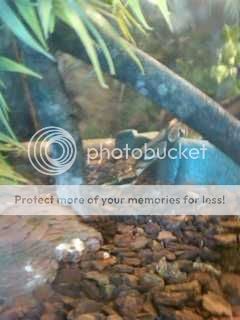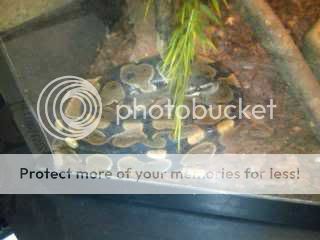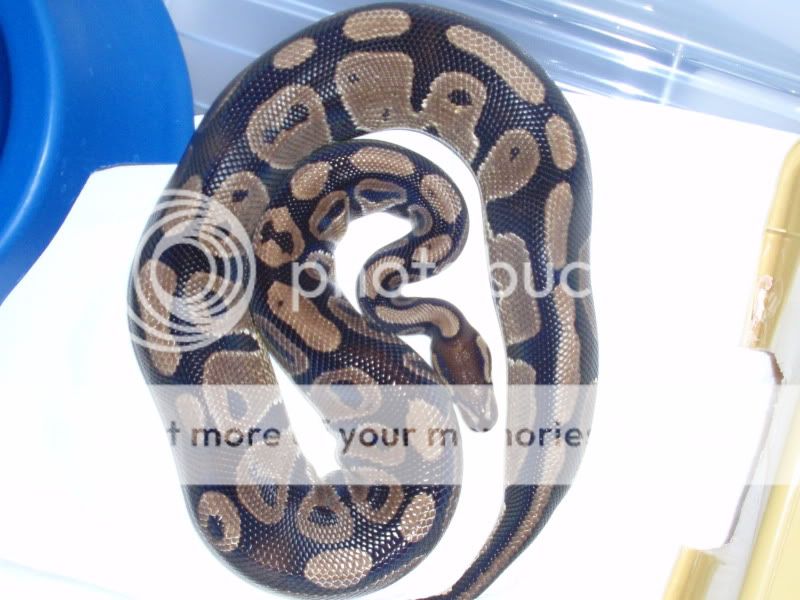If he takes well to rats, start thinking about spacing his feedings out more. Ideally, an adult ball python should be fed on an appropriately sized rat once every 2-3 weeks.
A CHE is a good idea if there's a risk of the temperatures dropping too low. Utilize a thermostat so you don't have to worry about the temps fluctuating as the heaters come on and go off at the building. If you decide to go high-end on your heat pad's thermostat, Herpstat sells a "Herpstat II" that's basically two thermostats in one. I own one, and LOVE it.
To make sure he has access to an area with good humidity, even if the rest of the enclosure dries out due to the CHE, you can utilize a humid hide... Basically a sterilite or similar tub, large enough to fit the snake, filled with sphagnum moss and kept moist. These are very useful. I've used them with excellent luck for corn snakes, boas, and ball pythons alike, among other things, to create humid micro-climates in otherwise "too" dry enclosures (usually indicated by bad (incomplete/piecey) sheds, at least in the case of the snakes). These especially help if you can't be there to mist as often as you would otherwise need to.
Though greenery is nice, and can help keep the enclosure nice and secure-feeling for the snake, nothing beats a good, enclosed hide... especially on the warm side! When they're digesting is the time that they feel the most vulnerable, and are the most in need of a good hide. I highly recommend getting a good hide for the warm side, at least so he has that option.
Just like illness, snakes will often hide signs of stress until it's a serious problem, because, if they showed that weakness in the wild, they'd pretty quickly become something's meal.
Signs of stress can be so small they're nearly unnoticeable... When handling a stressed snake, you'll often see the snake doesn't move around much and doesn't tongue-flick much. A healthy, relaxed snake will actively tongue-flick as it investigates its surroundings, and will move around some, even if it's minimal. As for a stressed snake in its enclosure, it'll often refuse to move much. In the case of a ball python, you may see it frequently curled into a defensive ball. Some snakes will hide constantly and refuse to come out, but this can be an especially difficult one to spot because some snakes are just shy and hide constantly regardless of whether they're stressed. Poor sheds can also be a sign of stress, but it can sometimes be difficult to determine whether it's because of stress, lack of humidity, or both (since lack of humidity can often cause stress, as well).
The more obvious signs include defensive behavior--hissing, s-coiling, and sometimes striking. In the case of ball pythons, you again have the defensive ball. As well are refusal to feed and regurgitation. Weight loss, which ties in some to refusal to feed, is also sometimes cited as a symptom of stress, though it's more often indicative of a parasite or other illness. (Healthy ball pythons will lose very little weight even in an especially long feeding strike... Some may refuse feed for a full year and not lose any noticeable weight.)
Stress can also cause illness, since it lowers the immune system. If the snake develops symptoms of an illness or parasite, these can often be considered indirect signs of stress and you need not only to correct the illness and whatever environmental issue may have caused the illness, but also remove whatever sources of stress may have lowered the snake's immune system.
When you go to measure his size--snakes are actually best measured by weight. Though length is nice to know, it doesn't really tell much. Weight is a much better indicator to health, size, what size prey you should be feeding, that sort of thing. Your snake could be any length, really, and snakes vary so much that length just doesn't tell you anything. To give you an example, my corn snake is a little over 3 feet long, roughly, but quite slender at almost 250 grams. I know corn snakes that are 3 feet long and anywhere from 300 to 600 grams. I would never be able to base what she might be able to eat on her length because, while a 3 ft/600 g corn might be able to take as large a prey item as a rat weanling (50 grams or so), my 3 ft/250 g corn would regurgitate anything larger than her usual small adult mouse (25 grams). Even within the same species, snakes are built differently. Length won't tell you much except, maybe, if your snake is fat... And even then, not really, because what's "fat" for one snake's build may be "normal" for your snake's build.
What I'm trying to say, in a probably round-about way (not the best writer, lol), is it's better to track your snake's size by weight. The standard measurement used is grams. You can get a cheap gram scale at a store like Walmart (look for kitchen scales that will measure at least up to 7 lbs or 3000 or so grams, in that range, so you can catch the whole spectrum of "normal" ball python weights) that will work perfectly fine for this.


 and pretty novice too! He eats adult mice once a week, anywhere between 1-3. He's never really been a picky eater and only refused to eat once when we first got him. He's active, alert, normal behavior. He has not had any health problems since I've had him. He recently had a good shed, about 3 weeks ago or so. I can't remember what size his viv is right now, though it is pretty good size, but I'll try to get pics soon to show the whole set up. I updated him almost immediately after I got him because the lady in the pet store, when I asked if the 10 gal. she was trying to sell me would last his lifetime, told me "sure that will be plenty big" and then I found out uh NO so I got a bigger one if I had to guess I would say 30-40 gal... He has a large water bowl, large log for a hide, under tank heater and heat rock, I know those can be bad but I've never had a problem with it and he loves it. Here is the bedding I use: http://www.petsmart.com/product/index.jsp?productId=2752663 We have moved around a great deal since we first got him so there may be some stress from all of that.
and pretty novice too! He eats adult mice once a week, anywhere between 1-3. He's never really been a picky eater and only refused to eat once when we first got him. He's active, alert, normal behavior. He has not had any health problems since I've had him. He recently had a good shed, about 3 weeks ago or so. I can't remember what size his viv is right now, though it is pretty good size, but I'll try to get pics soon to show the whole set up. I updated him almost immediately after I got him because the lady in the pet store, when I asked if the 10 gal. she was trying to sell me would last his lifetime, told me "sure that will be plenty big" and then I found out uh NO so I got a bigger one if I had to guess I would say 30-40 gal... He has a large water bowl, large log for a hide, under tank heater and heat rock, I know those can be bad but I've never had a problem with it and he loves it. Here is the bedding I use: http://www.petsmart.com/product/index.jsp?productId=2752663 We have moved around a great deal since we first got him so there may be some stress from all of that.





